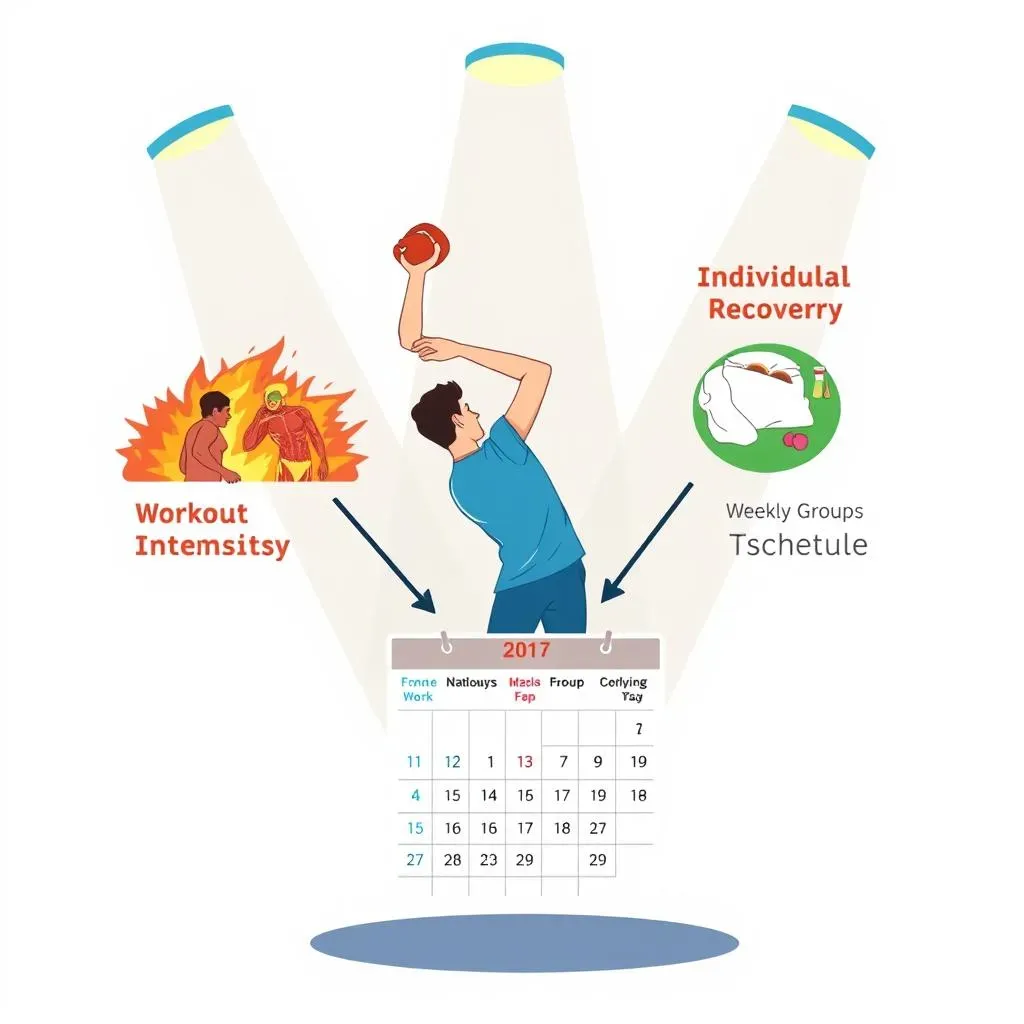Table of Contents
Kettlebell workouts have exploded in popularity, and for good reason. They're a fantastic way to build strength, torch calories, and improve your overall fitness. But with all the enthusiasm, a crucial question often arises: how many times a week should you do kettlebell workouts to see real results without overdoing it? This article will guide you through the factors that determine the ideal kettlebell workout frequency for you, helping you strike the perfect balance between pushing your limits and allowing your body the rest it needs to recover and rebuild. We'll explore how workout intensity, muscle groups targeted, and your individual fitness level all play a role in crafting a personalized kettlebell schedule. Get ready to discover sample routines, learn how to listen to your body's signals, and fine-tune your training for optimal gains. Let's dive in and unlock the secrets to a successful and sustainable kettlebell journey!
Understanding Kettlebell Workout Frequency for Optimal Results

Understanding Kettlebell Workout Frequency for Optimal Results
The Foundation: Why Frequency Matters
So, you're ready to swing some bells, huh? Awesome! But before you jump in headfirst, let's talk frequency. How often you train with kettlebells is super important. It's not just about blasting your muscles every day; it's about finding that sweet spot where you're challenging yourself enough to see progress, but also giving your body the time it needs to recover and get stronger. Think of it like this: you're not just breaking down muscle fibers when you work out; you're also building them back up. And that rebuilding happens during rest.
If you're constantly hammering away without adequate rest, you're setting yourself up for fatigue, injury, and potentially even burnout. On the flip side, if you're not training frequently enough, you might not be providing enough stimulus to trigger muscle growth and strength gains. Finding the right frequency is key to unlocking your kettlebell potential and achieving your fitness goals.
Beginner's Luck: Starting Slow and Steady
New to the kettlebell game? Welcome! When you're just starting out, it's best to ease into things. Your body needs time to adapt to the new movements and demands of kettlebell training. Jumping into a high-frequency routine right away can lead to soreness, injury, and discouragement. I've seen it happen too many times. Start with 2-3 kettlebell workouts per week, with at least one full rest day in between each session. This allows your muscles to recover and rebuild, and it gives you time to learn proper form and technique.
Focus on mastering the fundamental kettlebell exercises, like swings, squats, and presses. As you get stronger and more comfortable with the movements, you can gradually increase the frequency and intensity of your workouts. Remember, consistency is key! It's better to start slow and build a solid foundation than to burn out quickly and give up.
Intermediate and Advanced: Upping the Ante
Been swinging kettlebells for a while and feeling good? Great! You can probably handle a bit more frequency. Intermediate and advanced kettlebell enthusiasts often train 3-4 times per week, or even more, depending on their goals and recovery abilities. However, it's important to listen to your body and adjust your training accordingly.
If you're doing high-intensity workouts or focusing on specific muscle groups, you might need more rest days. Experiment with different workout schedules and see what works best for you. Consider incorporating active recovery days, such as light cardio or stretching, to help improve blood flow and reduce muscle soreness. And don't forget about the importance of proper nutrition and sleep! These factors play a crucial role in recovery and performance.
Experience Level | Recommended Frequency | Focus |
|---|---|---|
Beginner | 2-3 times per week | Mastering form, building a base |
Intermediate | 3-4 times per week | Increasing intensity, adding variety |
Advanced | 4+ times per week | Specialized training, optimizing recovery |
Factors Influencing Your Kettlebell Workout Schedule

Factors Influencing Your Kettlebell Workout Schedule
Workout Intensity: Are You Going Hard or Going Home?
Let's be real, not all kettlebell workouts are created equal. A light, technique-focused session is way different from a balls-to-the-wall, high-rep grinder. The intensity of your workouts plays a HUGE role in how frequently you can train. If you're consistently pushing yourself to the limit with heavy weights and challenging exercises, your body will need more time to recover. Think about it – you're creating more muscle damage, depleting your energy stores, and putting more stress on your central nervous system.
On the other hand, if you're focusing on lower-intensity workouts with lighter weights and longer rest periods, you can probably train more frequently without risking overtraining. Consider varying the intensity of your workouts throughout the week to allow for adequate recovery. Maybe do a couple of high-intensity sessions and a couple of lower-intensity sessions, or alternate between heavy and light days. The key is to listen to your body and adjust your training based on how you're feeling.
For example, imagine you're doing a brutal kettlebell circuit with exercises like snatches, Turkish get-ups, and thrusters. That's going to require more recovery time than a session focused on goblet squats and rows. Be honest with yourself about how hard you're pushing, and factor that into your workout schedule.
Muscle Groups Targeted: Give Those Muscles a Break!
Another crucial factor to consider is which muscle groups you're targeting in your kettlebell workouts. Just like with any other form of resistance training, you need to allow adequate recovery time for the muscles you're working. If you're consistently hammering the same muscle groups day after day, you're going to run into problems. Overtraining can lead to muscle soreness, fatigue, and even injury.
Consider splitting up your kettlebell workouts into different focus days. For example, you might have a day dedicated to lower body exercises, a day for upper body exercises, and a day for full-body movements. This allows you to work different muscle groups while still allowing adequate recovery time for each. You could also alternate between push and pull exercises to avoid overworking specific muscles. For instance, pair kettlebell swings (a posterior chain exercise) with push-ups (a chest and triceps exercise).
It's also worth noting that some muscle groups recover faster than others. Smaller muscle groups like the biceps and triceps tend to recover more quickly than larger muscle groups like the legs and back. Keep this in mind when planning your workout schedule. A good rule of thumb is to allow at least 48 hours of rest between workouts that target the same muscle groups.
Individual Recovery and Overall Health: It's All About You!
This is a big one, and it's often overlooked. Everyone's body is different, and everyone recovers at a different rate. Factors like age, genetics, sleep quality, nutrition, stress levels, and overall health can all impact your recovery abilities. What works for one person might not work for another, so it's important to find what works best for YOU.
If you're young, healthy, and getting plenty of sleep, you might be able to handle more frequent kettlebell workouts than someone who's older, stressed out, and not sleeping well. Pay attention to your body's signals and adjust your training accordingly. Are you feeling constantly sore and fatigued? Are you struggling to recover between workouts? If so, you might need to reduce your training frequency or intensity.
Make sure you're prioritizing sleep, nutrition, and stress management. Aim for at least 7-8 hours of quality sleep per night, eat a balanced diet rich in protein, healthy fats, and complex carbohydrates, and find healthy ways to manage stress, such as meditation, yoga, or spending time in nature. Remember, recovery is just as important as training. If you're not taking care of your body, you're not going to see the results you want.
Sample Kettlebell Workout Routines and Weekly Schedules

Sample Kettlebell Workout Routines and Weekly Schedules
Beginner-Friendly Full Body Blast
Alright, newbie kettlebellers, this one's for you! We're talking about building a solid foundation without overwhelming your system. This routine focuses on fundamental movements, ensuring proper form and technique. Aim for 2-3 workouts per week, with a rest day in between. Remember, quality over quantity is the name of the game here.
- Warm-up: 5 minutes of light cardio and dynamic stretching (arm circles, leg swings)
- Workout:
- Kettlebell Swings: 3 sets of 10-12 reps
- Goblet Squats: 3 sets of 8-10 reps
- Kettlebell Rows: 3 sets of 8-10 reps per arm
- Overhead Press: 3 sets of 6-8 reps per arm
- Plank: 3 sets, holding for 30-60 seconds
- Cool-down: 5 minutes of static stretching (holding each stretch for 30 seconds)
Intermediate Kettlebell Strength and Conditioning
Feeling a bit more confident with the basics? Time to crank things up a notch! This routine introduces more challenging exercises and variations, targeting multiple muscle groups simultaneously. You can perform this routine 3-4 times per week, depending on your recovery abilities. Don't be afraid to adjust the weight and reps to match your strength level.
Let's say you have been doing this for 2 months, you will feel confident and be able to lift heavier, and you will feel more active. That is the time to move to the next level!
Day | Workout |
|---|---|
Monday | Kettlebell Clean and Press: 3 sets of 6-8 reps per arm, Kettlebell Front Squats: 3 sets of 8-10 reps |
Wednesday | Kettlebell Swings: 3 sets of 15-20 reps, Turkish Get-Ups: 3 sets of 1-2 reps per side |
Friday | Kettlebell Snatches: 3 sets of 5-8 reps per arm, Kettlebell Rows: 3 sets of 10-12 reps per arm |
Advanced Kettlebell Power and Endurance
kettlebell masters, this one's for you! This routine is designed to push your limits, build serious strength and power, and improve your cardiovascular endurance. It's intense, so make sure you're properly warmed up and prepared. Aim for 4+ workouts per week, but listen to your body and take rest days when needed. This is not for the faint of heart!
These are the exercise you will do:
- Double Kettlebell Clean and Jerk: 3 sets of 5-8 reps
- Kettlebell Windmills: 3 sets of 5-8 reps per side
- Kettlebell Long Cycle (Clean and Jerk): 3 sets of 3-5 minutes
- Kettlebell Renegade Rows: 3 sets of 8-10 reps per arm
Remember to focus on maintaining proper form throughout the entire workout. Don't sacrifice technique for speed or weight. If you're feeling any pain, stop immediately and consult with a qualified healthcare professional.
Listening to Your Body: Adjusting Your Kettlebell Workout Frequency

Listening to Your Body: Adjusting Your Kettlebell Workout Frequency
Decoding Your Body's Signals
Alright, let's get real. Those sample schedules are great starting points, but they're not set in stone. The most important thing is to listen to your body and adjust your kettlebell workout frequency based on how you're feeling. Your body is constantly giving you feedback, and it's up to you to pay attention. Are you feeling unusually sore or fatigued? Are you struggling to complete your workouts? Are you experiencing any pain or discomfort? These are all signs that you might need to dial back your training.
Don't be afraid to take an extra rest day or two if you need it. It's better to err on the side of caution than to push yourself too hard and risk injury. Remember, consistency is key, but consistency doesn't mean training through pain. It means finding a sustainable workout schedule that you can stick with over the long term. Learn to differentiate between normal muscle soreness and pain that indicates a potential problem. Soreness is usually a dull ache that subsides within a day or two, while pain is sharper and more persistent.
The Art of the Deload
Ever heard of a deload week? It's a game-changer! A deload week is a period of reduced training volume and intensity, typically lasting one week. It's designed to give your body a chance to fully recover and rebuild, and it can help prevent overtraining and burnout. During a deload week, you might reduce your training frequency, decrease the weight you're lifting, or simply focus on lighter, less demanding exercises.
Think of it like this: you're not just training your muscles when you work out; you're also training your central nervous system. And your nervous system needs time to recover just like your muscles do. A deload week gives your nervous system a chance to recharge, which can lead to improved performance and reduced risk of injury. I typically schedule a deload week every 4-6 weeks, but you can adjust this based on your individual needs and preferences. Trust me, your body will thank you for it!
Finding Your Kettlebell Sweet Spot: Consistency and Listening to Your Body
Ultimately, determining how many times a week you should do kettlebell workouts is a personal journey. There's no one-size-fits-all answer. The key is to start with a manageable schedule, pay close attention to how your body responds, and adjust accordingly. Consistency is crucial for seeing results, but so is allowing adequate rest and recovery. By balancing intensity with recovery, incorporating variety into your workouts, and fueling your body with proper nutrition, you'll be well on your way to achieving your fitness goals with kettlebells. Remember, patience and self-awareness are your greatest allies in this process. Keep experimenting, keep learning, and most importantly, keep enjoying the process of becoming stronger and healthier!